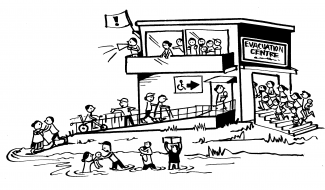Submitted by ManuelRothe
on Tue, 09/24/2019 - 18:45
Ensuring no one is left behind during evacuation requires specific preparation. The following actions will help with an inclusive evacuation:
- Identify in advance the persons in the community who may need assistance in evacuating.
- Support the establishment of individual support networks, including family, friends, neighbours or co-workers who are able to provide assistance to persons with disabilities, older people and other at-risk persons on a short notice in case of a disaster.
- Train rescue teams in the use of the proper tools and techniques, communication and attitudes for inclusive evacuations.
- Include persons from different at-risk groups in evacuation exercises, including persons with physical and sensory disabilities (deaf- and blind persons), children, older persons and pregnant women. Avoid simulations or role play exercises where persons without disabilities take the role of persons with disabilities.
- In evacuation planning, consider the needs and capabilities of persons who are deaf, hard of hearing, blind, have low vision, intellectual disabilities, limited endurance, respiratory conditions, are in need of psychosocial or mental health support, are pregnant or have other needs that will impact their ability to take personal protective measures and evacuate to a safe location.
- Raise awareness among at-risk groups in the community about evacuation planning. In case a person relies on personal assistants or care givers, ensure that both the person and their assistants are aware of how to evacuate safely.
- Work with persons who are living in institutions (e.g., psychiatric hospitals, orphanages or institutions for children without parents or centers for children with disabilities) to prepare for safe evacuations.
- Provide early warning and actionable messages for evacuation in accessible formats combining sirens, signal lights and vibrating phone messages with door-to-door and social media messages.
- Ensure evacuation routes and paths always remain accessible.
- Arrange transportation for evacuating people who have mobility limitations or do not have access to transportation.
- Ensure evacuation shelters or collective centres are accessible for everyone.
During evacuation:
- Ask people directly how you can best assist them in evacuating the area.
- Speak in a calm, low-pitched voice, and explain what is going on before suddenly moving someone.
- Apply a respectful attitude and communication manner when supporting persons with disabilities or older persons.
- Secure assistive devices and medication of persons with disabilities, older persons and persons who are chronically ill as well as supplies needed for an emergency birth for pregnant women and baby food and hygiene items for infants during evacuation.
- Pay close attention to the evacuation needs of persons who may be inadvertently or purposely left behind, including persons with the most significant disabilities, persons who are very poor, very old or young and those with complex medical conditions.

©Julie Smith